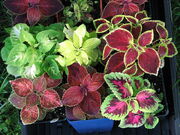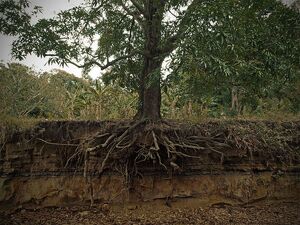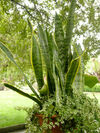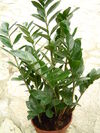No edit summary |
(→What kind of plant can become a houspelant?: spelling) |
||
| Line 3: | Line 3: | ||
| − | ==What kind of plant can become a |
+ | ==What kind of plant can become a houseplant?== |
[[File:Mangifera_indica_roots_cross_section.jpg|thumb|right|300px|A mango tree (''[[Mangifera indica]]''). While planting mango seeds is easy and usually results in a nice plantling sprouting, like every other tree, it soon gets too big for growth inside.]] |
[[File:Mangifera_indica_roots_cross_section.jpg|thumb|right|300px|A mango tree (''[[Mangifera indica]]''). While planting mango seeds is easy and usually results in a nice plantling sprouting, like every other tree, it soon gets too big for growth inside.]] |
||
Technically, all plants growing on Earth could potentially become a houseplant. However, in practice, only a small array of all of the plants of our planet eventually makes it inside our houses. The main reasons behind this are aesthetics, size, rarity and growth requirements. |
Technically, all plants growing on Earth could potentially become a houseplant. However, in practice, only a small array of all of the plants of our planet eventually makes it inside our houses. The main reasons behind this are aesthetics, size, rarity and growth requirements. |
||
Revision as of 13:04, 16 July 2010

Coleus are common houseplants.
A houseplant is a plant that is cultivated inside a residence or an office. They are chiefly grown for decorative and air-purifying purposes. Houseplants are most commonly tropicals or semi-tropicals.
What kind of plant can become a houseplant?

A mango tree (Mangifera indica). While planting mango seeds is easy and usually results in a nice plantling sprouting, like every other tree, it soon gets too big for growth inside.
Technically, all plants growing on Earth could potentially become a houseplant. However, in practice, only a small array of all of the plants of our planet eventually makes it inside our houses. The main reasons behind this are aesthetics, size, rarity and growth requirements.
The first reason why people begin to grow houseplants is usually because they look good and make interesting decorative additions inside a house or apartment; many plants just don't look good enough to be commercially viable as houseplants (one would hardly imagine dandelions, for instance, sold in stores as houseplants).
Also, many plants simply grow too big to be kept inside for more than an ephemeral period. This holds for most trees, for instance, who may find adequate conditions inside, but eventually get too big to be kept inside. A compromise to this may be seen for some species as bonsai training.
Additionally, many plants have growing requirements that simply cannot be met inside a typical house without completely altering the lifestyle of its occupants in the best case. Many plants have way too high light, moisture or temperature requirements that can't be reproduced inside a house. Greenhouses may allow some of those extremely demanding plants to grow correctly.
Best houseplants for beginners

Aglaonema commutatum

Aspidistra elatior


Sansevieria trifasciata

Spathiphyllum

Zamioculcas zamiifolia
Several plants that can grow inside our house are particularly well suited for the neophytes who wish to begin trying their hand at houseplant keeping and horticulture. Those very robust plants can stand the worse beginners' mistakes and still thrive. Here is a list of some of these hard-to-kills:
- Aglaonema commutatum: this plant is sometimes called Chinese evergreen and is known for its beautiful foliage and its tolerance to various light conditions, neglect and to pests.
- Aspidistra elatior: dubbed the cast iron plant, it will tolerate the worse neglects and still do well in rather shady houses.
- Cyperus alternifolius: a plant perfect for those who tend to over water their plants to the point of killing them, the umbrella plant simply loves over watering - in fact, leaving its pot in a large bowl full of water and giving it some light is all it needs to be happy and reward its owner with very exotic up to three feet tall stems that readily fill the whole pot.
- Philodendron scandens: the heart-leaf philodendron is not very demanding in term of watering and does just fine even far from windows. They have a tendency to trail as they grow, making them interesting hanging-basket candidates.
- Sansevieria: this plant stands very well irregular watering (and actually prefers so, dealing very well with a single watering every couple of month during winter) and poor light conditions. It is also a good air cleaner.
- Spathiphyllum: this plant requires little light to thrive, has a nice look and, best of all, is an excellent air cleaner.
- Zamioculcas zamiifolia: commonly named the Zanzibar gem of the ZZ plant, Zamioculas is literally impossible to kill. It will do well in dim areas and can stand weeks of water deprivation because it grows from a tuber that stores water for tougher periods of his tough native area, eastern Africa.
Care to give to houseplants
Basically, caring for houseplants imply controlling eight factors of importance to their growth, them being moisture, light, soil mixture, temperature, humidity, fertilizers, potting, and pest control. Houseplants bought in stores often come with a little tag describing the basic requirements of the plant, but those tags are notoriously known to be unhelpful; various guides exist, be it in books or online (the present Wiki being one such) to help people adequately grow their plants.
Moisture
Every plant requires water to grow; however, not every plant requires the same amount, and to make things worse, most plants will suffer if over- or under-watered. Most plants should be permitted to reach a certain level of soil dryness before being watered again, to imitate to some extent the rain frequency of their native habitats. Relying to water-meters when the heart should be watered is generally a bad idea, as they tend to be inaccurate. The best way to do so is to directly feel the moisture of the soil by planting a finger in it.
Another technique is to gauge the content of water of the soil of a plant by lifting the pot. Completely dry pots will typically be much lighter than soaked ones, and with some practice, it is possible to evaluate approximately how much water is left in the soil, and depending on the plant growing in it, whether watering is advised or not.
Light
Unlike animals and humans who get all of their food by eating something else, plants do not do such a thing; they rather rely on photosynthesis, which is , to make things simple, the conversion of solar energy into chemical energy, which the plant uses to live. So obviously, the vast majority of plants require to be exposed to light in order to grow. There again, it is all a matter of quantity: some plants require full-sun exposure, while other prefer partial or even full shades (those are typically plants that grow in forests).
The best way to give a plant the light it needs is to place it near a window. In the Northern Hemisphere, windows facing south provide the longest periods of light (the opposite goes in the Southern Hemisphere). Eastern and Western oriented windows provide gradually decreasing or increasing light.
When windows are not available, artificial lighting can replace it to some extent, but not all artificial light sources do equally well. Fluorescent light tends to help plant growth, while typical incandescent lighting does little to promote it, because they are not bright enough. While our eyes hardly makes the difference, sensitive instruments called light meters will express a difference of lighting in a unit called lux. Typically, 100 lux or less is considered "low intensity" or "indirect" lighting. A bright office has about 400 lux of illumination. 1,000 lux or more is usually considered "high intensity" lighting. Direct outdoor sunlight is in the range 32,000-100,000 lux.
Soil mixture
Different plants grow in different habitats in the world, and it is indeed plants from these different habitats that we bring in our homes as houseplants. Logically, all those plants will have different requirements at the level of soil too, some preferring alkaline soil, some acid, poor or rich, well drained or not, etc.
Soils bought in commerce nowadays are generally specialized soils called potting soil or potting compost that have been designed to satisfy many plants. These mixtures include soil conditioners to provide nutrients, support, adequate drainage, and proper aeration. Peat is a major constituent of potting soil; however, due to the environmental damages its extraction causes to the precious peat bogs, peat is increasingly being replaced by coconut fiber, called coir.
Local natural soil can most certainly be used to grow houseplants, but it has to be sterilized first by putting it in an oven at 90 °C (200 °F) for at least 30 minutes. However, some more manipulations may be necessary before it can be used as a growth medium. Indeed, natural soil may contain too much sand or clay, and consequently drain too fast or too slowly (though some plants may still love it). It is recommended to mix your soil with coir or peat for an increased aeration (in nature provided by invertebrates such as earthworms). Vermiculite and perlite are musts when it comes to drainage of the soil; the second is latter than the former because it doesn't break down in pieces as easily.